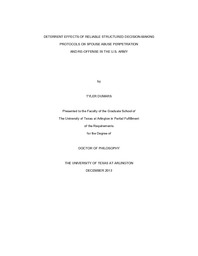
ATTENTION: The works hosted here are being migrated to a new repository that will consolidate resources, improve discoverability, and better show UTA's research impact on the global community. We will update authors as the migration progresses. Please see MavMatrix for more information.
Show simple item record
| dc.contributor.author | DuMars, Tyler | en_US |
| dc.date.accessioned | 2014-03-12T23:50:54Z | |
| dc.date.available | 2014-03-12T23:50:54Z | |
| dc.date.issued | 2014-03-12 | |
| dc.date.submitted | January 2013 | en_US |
| dc.identifier.other | DISS-12406 | en_US |
| dc.identifier.uri | http://hdl.handle.net/10106/24121 | |
| dc.description.abstract | Since the early 1980s, victims' rights advocates, law enforcement officials, health care practitioners, and policymakers have all worked diligently to reduce or arrest the high levels of intimate partner violence (IPV) in military communities. Despite increased awareness and funding, new treatment approaches, and numerous policy changes, IPV in the military continues to be a deeply entrenched and recalcitrant problem. In January 2008, the Army began using a structured decision-making protocol (the Decision Tree Algorithm) that requires users to assess whether alleged incidents of intimate partner abuse coincide with evidence-based maltreatment definitions, and indicate that actual harm (or the potential for harm) was inflicted upon the victim. This study assessed the deterrent effects of this new decision-making system on the rates of spouse abuse perpetration and re-offense in the U.S. Army. Determinants of incident substantiation and re-offense such as sociodemographic characteristics, alcohol use, command participation, and installation deployment loads were also evaluated. The guiding principles for this research were derived from a theoretical framework that integrated Cognitive Behavioral, Social Learning, Cultural Dimensions, Feminist, Deterrence, and Biological theories under the rubric of Bioecological Systems Theory. Five datasets were systematically selected for analysis from an Army Central Registry containing 78,874 unique spouse abuse incidents from 2003-2013. The spouse abuse incidents were nested among 82 Army installations in the U.S. and around the world. Chi-square and multilevel logistic regressions were used to test for associations between the time-period (before or after the implementation of the DTA) when an incident was determined and the outcome variables (spouse abuse perpetration and re-offense). Multilevel logistic regressions were used to determine which of the independent variables significantly increased or decreased the likelihood of spouse abuse perpetration and re-offense. Consistent with extant literature, the rate of spouse abuse incident substantiation and re-offense dropped significantly after the Army began using the new structured decision-making protocols to make incident determinations. Sociodemographic characteristics such as male gender, non-military spouse, and alcohol use were the greatest risk factors for incident substantiation. Male gender, non-military spouse, and lack of command participation were risk factors for re-offense. Installation deployment loads were not significantly associated with incident substantiation or re-offense. The findings suggest that there are deterrent effects associated with the use of structured decision-making protocols on spouse abuse perpetration and re-offense in the Army. Future research should explore the viability of using similar structured decision-making protocols in civilian settings, such as domestic violence problem-solving courts, where currently no such guidelines exist. | en_US |
| dc.description.sponsorship | Smith-osborne, Alexa | en_US |
| dc.language.iso | en | en_US |
| dc.publisher | Social Work | en_US |
| dc.title | Deterrent Effects Of Reliable Structured Decision-making Protocols on Spouse Abuse Perpetration And Re-offense in the U.S. Army | en_US |
| dc.type | Ph.D. | en_US |
| dc.contributor.committeeChair | Smith-Osborne, Alexa | en_US |
| dc.degree.department | Social Work | en_US |
| dc.degree.discipline | Social Work | en_US |
| dc.degree.grantor | University of Texas at Arlington | en_US |
| dc.degree.level | doctoral | en_US |
| dc.degree.name | Ph.D. | en_US |
Files in this item
- Name:
- DuMars_uta_2502D_12406.pdf
- Size:
- 2.334Mb
- Format:
- PDF
This item appears in the following Collection(s)
Show simple item record


